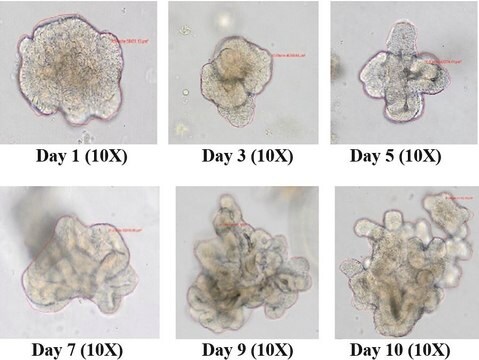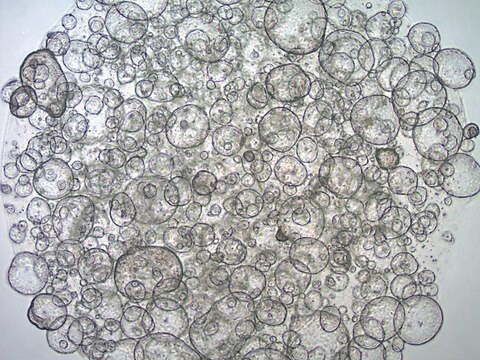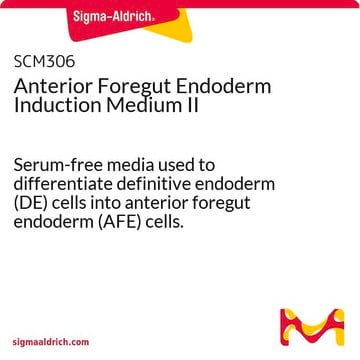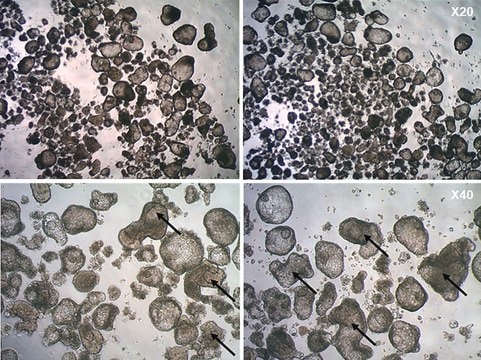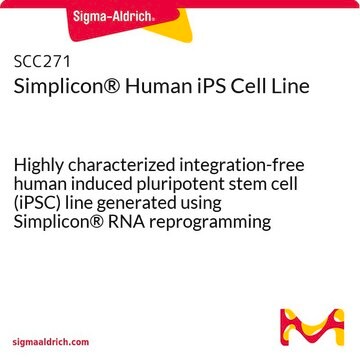SCC300
3dGRO®-iPSC-Kolonorganoide, human
Synonym(e):
Human Colon Organoids, Human Colonoids, Human Gut Organoids, Human Intestinal Organoids
About This Item
Empfohlene Produkte
Form
liquid
Methode(n)
cell culture | stem cell: suitable
Anwendung(en)
cell analysis
Allgemeine Beschreibung
Das humane 3dGRO®-iPSC-Kolonorganoid wird aus integrationsfreien humanen iPS-Zellen gewonnen (Art.-Nr. SCC271) und mit der Simplicon-RNA-Reprogrammierungstechnologie (Art.-Nr. SCR550) neu programmiert. Die Differenzierung der humanen iPS-Zellen erfolgte in einem mehrstufigen Verfahren vom definitiven Endoderm zum posterioren Hinterdarmendoderm und schließlich zu Kolonorganoiden (Abbildung 1). Die Organoide exprimieren kolonspezifische Marker, einschließlich der Hinterdarmmarker CDX2, α-Carbonanhydrase II (CA-II), α-Carbonanhydrase IV (CA-IV) und Becherzellmarker Mucin-2 und Mucin-5B. Humane 3dGRO®-iPSC-Kolonorganoide können langfristig durch Passage alle 10-12 Tage mit einem humanen 3dGRO®-Kolonorganoid-Expansionsmedium (Art.-Nr. SCM304) gezüchtet werden.
Anwendung
Forschungskategorie:
- Zellkultur
- Stammzellenforschung
Qualität
- Jedes Fläschchen enthält ≥ 1500 Organoide.
- Mykoplasma: Negativ
- Genotypisiert durch STR-Analyse: Entspricht
- Nachweislich humanen Ursprungs
- Die Organoide werden mittels PCR negativ auf HPV-16, HPV-18, Hepatitis A, B, C und HIV-1- & -2-Viren getestet.
- Lebensfähigkeit von Zellen: Entspricht
Lagerung und Haltbarkeit
Rechtliche Hinweise
Haftungsausschluss
Lagerklassenschlüssel
12 - Non Combustible Liquids
WGK
WGK 1
Flammpunkt (°F)
does not flash
Flammpunkt (°C)
does not flash
Analysenzertifikate (COA)
Suchen Sie nach Analysenzertifikate (COA), indem Sie die Lot-/Chargennummer des Produkts eingeben. Lot- und Chargennummern sind auf dem Produktetikett hinter den Wörtern ‘Lot’ oder ‘Batch’ (Lot oder Charge) zu finden.
Besitzen Sie dieses Produkt bereits?
In der Dokumentenbibliothek finden Sie die Dokumentation zu den Produkten, die Sie kürzlich erworben haben.
Artikel
Human epithelial intestinal colonic organoids can be used as an alternative to Caco-2 drug permeability assays for drug screening and compound toxicity testing.
Organoid culture FAQs. Learn how to culture and analyze organoids following established 3D cell culture protocols. Tips and tricks.
Protokolle
Highly characterized cryopreserved human colonic organoids and a step-by-step organoid culture protocol for epithelial intestinal organoid differentiation from iPS cells.
Learn how to cultivate similar-sized iPSC-derived colon organoids using Millicell® Microwell plates and perform a forskolin-induced swelling assay.
Verwandter Inhalt
Our broad range of the most trusted tools for cell culture includes stringently sourced and tested FBS, established media formulations, and sterile labware. Cutting-edge techniques using stem cells and 3D matrices are enabled by organoids, hydrogels, culture scaffolds, and bioinks for 3D bioprinting.
Monitor barrier formation using colon PDOs, iPSC-derived colon organoids, Millicell® cell culture inserts, and the Millicell® ERS. 3.0.
Explore our portfolio of 3D cell culture tools and technologies for any 3D cell line or application and discover organoids, hydrogels, ULA, microwell, or hydrogel plates, and more.
Unser Team von Wissenschaftlern verfügt über Erfahrung in allen Forschungsbereichen einschließlich Life Science, Materialwissenschaften, chemischer Synthese, Chromatographie, Analytik und vielen mehr..
Setzen Sie sich mit dem technischen Dienst in Verbindung.